Walls made of durable and lightweight expanded clay concrete retain heat in the house. The widespread material is environmentally friendly, fungus does not develop on it, the cost of stones allows them to be used in the mass construction of private buildings. Everyone can build a house from expanded clay concrete blocks (KBB) with their own hands, you just need to know the specifics of the material.
- Characteristics of expanded clay concrete blocks
- What type of foundation is suitable for a house from KBB
- The process of erecting a building from blocks
- Pouring the foundation
- Wall masonry made of expanded clay concrete blocks
- Roof arrangement
- How to insulate a house from expanded clay concrete blocks from the outside
- Insulation of the blind area of the base
- Exterior wall decoration
Characteristics of expanded clay concrete blocks
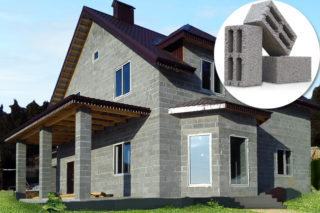
Building material is made from a mixture of cement with sand and the addition of fired clay particles. Expanded clay concrete turns out to be light, while its strength allows it to withstand the weight of the floor. Dry walls are erected, which provide good thermal insulation.
Block dimensions:
- 290 x 390 x 188;
- 190 x 390 x 188.
KBBs are larger than bricks, so houses from expanded clay concrete blocks can be built faster and with less labor costs. The amount of masonry mortar decreases, because the length of the seams decreases. In the southern regions, a wall is made in one block (300 mm) with external insulation, and in the northern regions they prefer laying in two layers (40 mm).
Expanded clay concrete has no problems with shrinkage under operational loads. The building material does not emit components hazardous to health into the environment, since the raw material belongs to natural species.
Positive traits:
- high sound insulation of the interior space;
- the ability to make the masonry with your own hands;
- good adhesion to facing materials.
The disadvantages include the latent porosity of expanded clay concrete, which is why it is moistened and is not used for laying the basement.
To calculate the number of blocks, calculate the volume of walls and partitions minus window and door openings. The result obtained is divided by the cubic capacity of one stone, taking into account the seam. The factor 1.1 takes into account the cutting of blocks to size when laying.
What type of foundation is suitable for a house from KBB
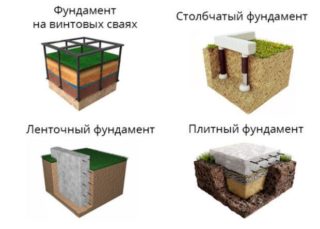
Blocks are classified as lightweight wall elements, so a house made of expanded clay concrete does not require a massive base. If experts identify a low standing of the soil liquid, and the soil belongs to the category of sand or sandy loam, a foundation is made of separate posts with a beam strapping. The strip foundation is made of shallow depth.
Two-story buildings on unstable soils require a strip base with a sole below the freezing point. In heaving soils, screw piles are placed, the tip of which is supported on a solid layer.
The foundation is calculated for strength, for this, the weight of the house from expanded clay blocks is determined. The load includes the mass of walls, floors, coatings, equipment, people, snow and wind loads, plus the weight of the foundation structures.
The ground pressure is compared with the calculated soil resistance, which is found in reference books for each type of soil separately. The first indicator should be less than the ability of the soil to resist the load. When choosing a base design, the freezing mark and the standing point of the soil liquid are taken into account.
The process of erecting a building from blocks
The technology includes the construction of the foundation, the laying of vertical fences, the installation of ceilings, coverings and roofs. The scope of work also includes wall insulation and exterior decoration. Wooden beams of country houses are laid on the walls, having previously organized a joint, and under the prefabricated slabs, a concrete belt with reinforcement along the top of the perimeter is required.
The foundation is deepened, taking into account the basement, and the walls in the ground are laid from red ceramic bricks, which are characterized by low hygroscopicity.
Pouring the foundation
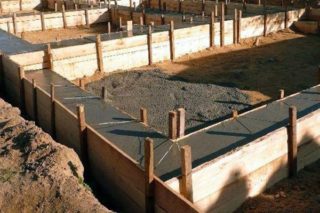
The construction of a house support from expanded clay concrete begins with the removal of the fertile layer. Then markings are made in the plan using a cord and pegs, the marking points are placed in the corners by 2 - 2.5 meters so that they do not fall when digging trenches.
Operating procedure:
- digging a trench for the foundation, taking into account the installation of the formwork to the design depth;
- make a bed of sand and crushed stone, tamp the layers;
- shields are set in width and supported with bars;
- a reinforcing cage is placed inside the shell, the joints of which are connected with knitting wire or welding;
- concrete is poured, electric vibrators are used for compaction.
The surface is covered with sawdust and regularly watered.
Concrete gains strength within 28 days, only after that they begin to build a basement.
Wall masonry made of expanded clay concrete blocks
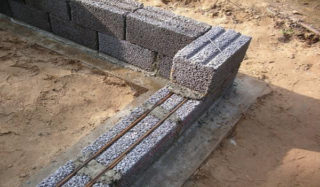
For masonry, blocks with exact dimensions are chosen so that there is no overrun of the solution on uneven seams. Better to order new blocks than to put used stones. Reinforcement of the masonry is done every 3 to 4 rows, using a stamped metal mesh.
Laying begins with corner elements, on which the twine is pulled (ordering). On this landmark, the subsequent blocks of the row are placed so as not to violate the horizontality. For masonry, use a cement-sand mortar or ready-made dry mixes, which are diluted with water.
Roof arrangement
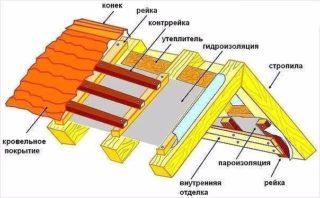
For the roof, a system of beams, slabs or small trusses are used. The floor material is metal, wood, reinforced concrete. On wooden rafters, a crate of bars with a section of 50x50 mm is placed for fastening slate, ondulin, metal tiles. Insulation, vapor barrier and a layer to protect against moisture are placed under the coating.
Plates are laid with support on walls or beams, if a transom system is provided. They make a mandatory slope of the roof so that moisture flows down the slopes. A system of organized drainage made of plastic or galvanized metal is mounted along the perimeter of the roof. It includes vertical pipes, the end of which is taken out of the blind area, or a special gutter is built.
How to insulate a house from expanded clay concrete blocks from the outside
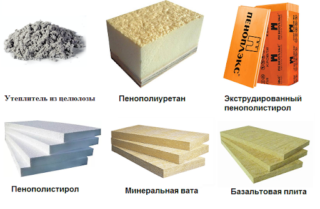
A house made of expanded clay blocks is insulated from the cold using materials with low thermal conductivity:
- mineral wool, basalt wool, fiberglass;
- polystyrene foam, polystyrene foam, polyurethane foam.
The first types are classified as loose materials that absorb moisture and therefore gradually lose their insulating properties. They must be waterproofed from roll films. Materials from the second group will last longer, because have isolated voids inside, into which water does not penetrate.
For the installation of heaters, a frame is made of metal profiles, between the elements of which insulators are attached. Another option is a wet finish on a layer of cotton wool or foam with a mesh.
Insulation of the blind area of the base
The concrete strip around the perimeter of the house is in contact with the soil and transfers heat, therefore it also requires insulation from the cold. The blind area protects the basement and foundation from rain streams and water when snow melts. Lay a horizontal layer of insulation before pouring the mortar. They make a sandy, then crushed stone bedding and concretes a protective strip up to 10 cm thick.
More often, foam and expanded polystyrene are used for insulation, becauselayers are laid in the ground and moisture acts on them. Be sure to make a slope from the wall of the house, and the width of the strip ranges from 0.8 to 1.2 meters.
Exterior wall decoration

Facade cladding has a decorative value and protects the walls from adverse factors.
Materials used:
- figured facing brick;
- plain or textured plaster;
- putty with cement compounds for facade work with subsequent painting;
- natural stone, artificial tiles;
- siding, plastic;
- thermal panels, glass, clinker tiles.
Wet formulations and tiles are fixed directly to the surface. For sheet and panel materials, a ventilated frame made of strips or a galvanized profile is arranged. The type of finishing is chosen depending on the preferences of the owner and the cost.








